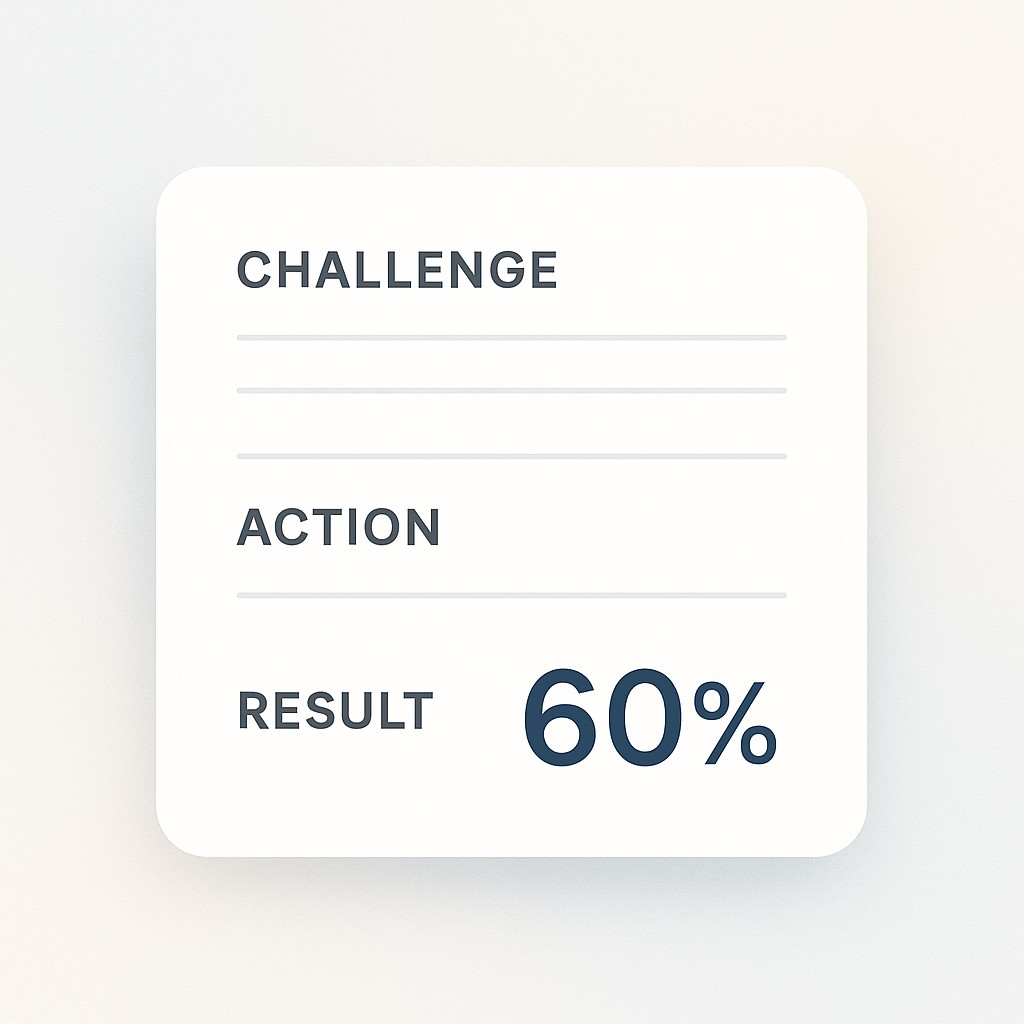How to Communicate Engineering Impact That Managers Notice
How to Communicate Engineering Impact That Managers Notice

Why Your Brag List Isn’t Landing
It happened after a sprint review. I’d stacked my updates into a tidy little list—projects shipped, bugs squashed, a gnarly migration wrangled. My manager scanned it, raised their eyebrows. “Wow… I didn’t know you did all this.” And then they moved on.
That surface-level recognition stung a little. “Thanks!” they said, and that was it. No curiosity, no questions, no real conversation about what went right or wrong. Honestly, I wasn’t even sure they meant it.
Here’s the thing I wish I’d admitted sooner. A list of accomplishments isn’t enough; how to communicate engineering impact starts with context—without it, your updates are just noise. I assumed the list spoke for itself. It didn’t, and that’s on me. What actually gets attention is a story. The challenge faced. The specific action taken. The result—with numbers, not hand-waving. That’s the CAR model (Challenge, Action, Result) and it’s the difference between “busy” and “impact.” When you frame work as a narrative, not just a set of tasks, managers can see the stakes, the choices, and the wins. It changes what they ask and how they advocate for you.
If your updates land with a polite nod and nothing else, you’re in the right place.
How Managers Think—And How to Communicate Engineering Impact with Outcome Stories
Managers skim for a reason. They’re tracking problems, stakes, and actual outcomes—never just activity. When you report disconnected tasks, you bury the signal they need for decisions. Lists look busy, but without context, you’re just listing motion, not impact. Here’s what happens in outcome-based cultures. Managers focus on results and let individual contributors shape the process to reach those goals—impact drives everything. They scan for value, not volume.
The antidote is simple, and you’ll use it everywhere once you see how well it lands. Six months ago I barely knew what a CAR story was, but once I started, everything shifted. Start with the CAR framework: first, name the Challenge—a specific problem or goal to set the stakes. Then show your Action—what you actually did, which makes ownership visible. Finally, quantify the Result. Numbers flip perception instantly.
“I cut API response time by 60%, making the app feel instant.” That’s not just a bullet point, it’s a story—anyone can see the change. Take this real snapshot. Challenge: Grow subscriber base and engagement. Action: launched a weekly newsletter. Result: boosted open rates by 28% and added 1,600 subscribers—numbers make the difference. When you swap vague outcomes for concrete metrics, managers know what moved and who moved it.

Let’s get precise. Say releases used to eat up two hours every Friday. The Challenge: slow, error-prone deployments. My Action: built an automated pipeline. Result: Deployments now take 15 minutes, reducing outages. That before-and-after—fast to scan, impossible to skim past—shows the real risk reduction and time saved.
Ownership jumps out when you’re direct. State your role and the measurable outcome, even if the team helped. “I led the onboarding revamp, reducing drop-offs by 30%.” That’s credit, clear as day. You’re not bragging, you’re showing cause and effect.
Here’s why managers lean in. A good CAR snapshot invites real conversation. When your updates move beyond rolling out features and start ensuring customers experience innovation and value, the scope for meaningful feedback and real impact expands. That’s when managers ask about tradeoffs, risks, what worked, what you’d do differently next time. CAR stories surface those details without needing a follow-up. The more context you offer, the faster feedback becomes useful—and the more visible ownership and results feel, even in routine weekly check-ins. That’s how you stop fading into the background and start shaping your own narrative.
Your Move: The Storytelling Playbook for Showcasing Your Work
Let’s make this simple. If you want to showcase engineering impact so your work sticks in your manager’s mind (and shows up in reviews and promotions), you need an operating guide for turning even the driest Jira task into a story that demands attention. This is your “Your Move” playbook—practical, flexible, and proven in the wild. Here’s how to make your work impossible to ignore.
The foundation is just five sentences, maybe six—the challenge action result framework that keeps your story tight. Lay out the Challenge—the real pain or goal, not just “what.” Name your Action, and make it specific. State the Result, quantified if possible. If you worked with others, say exactly what you owned (“led migration,” “designed fix,” “implemented test suite”)—not just “helped.” Last, drop in either a number or evidence: a concrete result, a graph moved, a customer unblocked. That’s it: Challenge, Action, Result, Ownership, Evidence. Every update you write can fit this skeleton, and the punchier you make these lines, the harder they land.
For numbers, don’t overthink it—focus on ways to quantify engineering outcomes. I used to torture myself waiting for the “real” metrics, parsing through Grafana dashboards, hunting for one golden data point while the update sat in drafts. That’s wasted motion. Pull from what you have: logs, A/B tests, error budgets, clear before-and-after graphs, even anecdotal but directionally correct impact—just be transparent about any estimates. If all you have is “load time improved from about 4s to 2s in high traffic,” say so. Ranges and rough percentages count, as long as you say how you got them. Honest directional numbers beat radio silence every time.
Ownership is where it gets real, especially on team efforts. For shared work, your piece—however small—deserves daylight. Instead of “team refactored,” try: “I designed and implemented the retry logic. The broader team managed QA and rollout.” Be explicit about your slice, but always nod to the collective win. It’s not about downplaying your partners, it’s about clarity. Managers need to see who drove what, not just what got shipped.
There was a week, maybe in my second year, when I hit every task assigned during sprint, closed all my tickets, even helped a teammate fix a gnarly Flask bug at 2AM. (Not proud of the hour.) When updates rolled in, that extra effort blended into everyone else’s velocity. Turns out, if your story gets lost in the shuffle, so does your impact. That API response time I mentioned earlier? If I’d buried it as “fixed performance issue,” nobody would remember.
So what does this sound like in practice? Here’s how updates transform:
- Instead of, “Refactored module,” try, “Refactored payment module, reducing p95 latency by 43%, enabling team to hit SLA for the first time this quarter.”
- Swap, “Wrote tests,” for, “Added 112 integration tests, increasing coverage to 87% and cutting regressions by 50% in post-release QA.”
- Forget, “Built dashboard,” and use, “Built automated error dashboard—cut incident response time by 70%, letting support teams close twice as many tickets per week.”
It’s not just about sounding better. It’s about impact storytelling for engineers that makes your actual impact visible, undeniable, and a springboard to the next real conversation—one that’s finally about what you changed, not what you did.
The Three Doubts That Keep CAR Stories on the Shelf
Let’s be honest. Writing a weekly CAR story sounds like one more thing on your list. But here’s what works. Set a 15-minute timer, jot down one new story each week, and stash it in your running doc. I’ve kept this habit for months. It takes less time than digging through old Slack threads later, trying to prove what changed because of me.
Worried about splitting credit on team projects? One trick is to map who owned which slice—design, rollout, testing—and use numbers for your specific piece where you can. “Owned rollout plan; our team cut failover time by 35%.” When it’s genuinely fuzzy, estimate a range and name every collaborator. No one expects a perfect pie chart.
If you’re hesitating because it feels self-promotional, flip it. This is about clarity, not ego. Say “we” for shared wins, “I” for what you drove, and always put partners up front. It’s documentation, not chest-thumping.
If a story reads like a brag, run a quick check. Add more context, show the numbers, and give credit. Suddenly, it’s not bragging—it’s evidence.
Some weeks, honestly, I just don’t feel like I changed the world. But I jot the story anyway. Not every update is dramatic, not every number is huge, and I still struggle to make the “small” work sound meaningful. I haven’t quite solved that yet.
Make Your Impact Routine, Not One-Off
Let’s talk workflow. Here’s how you turn storytelling into a weekly rhythm instead of a one-time “I should do more of this.” Block out 10–15 minutes once a week. Friday after standup works for me—keep a living doc where you jot down one fresh CAR story: Challenge, Action, Result. Drop it into your status email or your weekly one-on-one agenda so managers see it without extra digging. Whenever possible, link your dashboards or tickets for backup. And when review season rolls around, you’ve already got a running archive, versioned with each update—the heavy lifting is done.
When it’s time for performance reviews or promotion packets, foreground engineering performance review impact by clustering your CARs by theme—think reliability, speed, or customer impact. Stack a few stories together for each area to show patterns and how your impact grew over time. This isn’t just for you. It gives managers exactly what they need before calibrations start, making your narrative shine on the first pass.
If you want help turning your CAR snapshots into clear, scannable updates with numbers and ownership baked in, use our AI to draft, refine the tone, and ship better status notes in minutes.
Here’s the real turning point. You don’t need a bigger list—you need clearer stories that show how to communicate engineering impact. So I stopped listing and started telling stories. Pick one project right now and write its CAR—challenge, what you did, the numbers that moved. See how it feels, and watch how quickly it changes the conversation next time your manager skims your update.
Self-awareness moment: if you don’t tell your story, no one else will.
This is post 5 of 11 in the Storytelling for Engineers series. More examples and templates are coming soon—try the playbook now and make your updates stand out each week.
Enjoyed this post? For more insights on engineering leadership, mindful productivity, and navigating the modern workday, follow me on LinkedIn to stay inspired and join the conversation.
You can also view and comment on the original post here .
